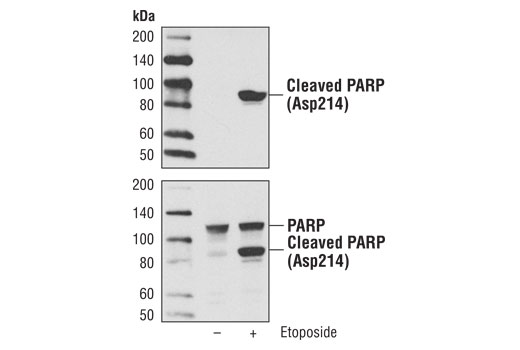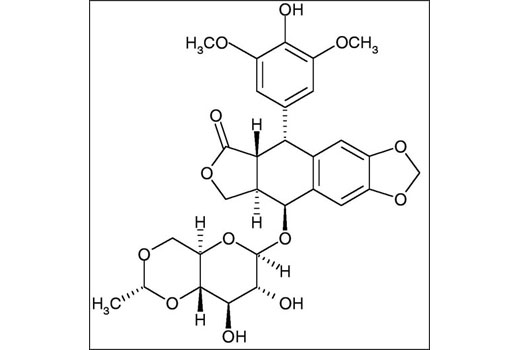Background
An anti-tumor agent that is commonly used as an apoptosis inducer, etoposide (VP-16) is a topoisomerase II inhibitor with an IC50 of 59.2 µM (1). Etoposide stabilizes a covalent topoisomerase II-cleaved DNA intermediate complex in the catalytic cycle of the enzyme, leading to genomic instability and cell death (2,3). This mechanism of action has been shown to delay progression of the cell cycle through the late S and early G2 phase (4,5).
Molecular Formula
C29H32O13
Molecular Weight
588.56 g/mol
Purity
>98%
CAS
33419-42-0
Solubility
Soluble in DMSO at 25mg/ml.
Storage
Directions for Use
Etoposide is supplied as a lyophilized powder. For a 50 mM stock, reconstitute the 5.9 mg in 200 µl DMSO. Working concentrations and length of treatments vary depending on the desired effect, but it is typically used at 5-50 µM for 4-24 hr. Soluble in DMSO at 25 mg/ml; very poorly soluble in ethanol and water with maximum solubility in water ~20-50 µM.
Wear personal protective equipment. Do not handle until all safety precautions have been read and understood.
Safety Information: Etoposide has been classified by the International Agency for Research on Cancer (IARC) as a known human carcinogen (Group 1). It may cause adverse reproductive effects - such as birth defect, miscarriages, or infertility. Avoid contact during pregnancy and while nursing. If exposed or concerned, get medical advice. See Safety Data Sheet (SDS).
Background References
Cross-Reactivity Key
H: human M: mouse R: rat Hm: hamster Mk: monkey Vir: virus Mi: mink C: chicken Dm: D. melanogaster X: Xenopus Z: zebrafish B: bovine Dg: dog Pg: pig Sc: S. cerevisiae Ce: C. elegans Hr: horse GP: Guinea Pig Rab: rabbit All: all species expected
Trademarks and Patents
Limited Uses
Except as otherwise expressly agreed in a writing signed by a legally authorized representative of CST, the following terms apply to Products provided by CST, its affiliates or its distributors. Any Customer's terms and conditions that are in addition to, or different from, those contained herein, unless separately accepted in writing by a legally authorized representative of CST, are rejected and are of no force or effect.
Products are labeled with For Research Use Only or a similar labeling statement and have not been approved, cleared, or licensed by the FDA or other regulatory foreign or domestic entity, for any purpose. Customer shall not use any Product for any diagnostic or therapeutic purpose, or otherwise in any manner that conflicts with its labeling statement. Products sold or licensed by CST are provided for Customer as the end-user and solely for research and development uses. Any use of Product for diagnostic, prophylactic or therapeutic purposes, or any purchase of Product for resale (alone or as a component) or other commercial purpose, requires a separate license from CST. Customer shall (a) not sell, license, loan, donate or otherwise transfer or make available any Product to any third party, whether alone or in combination with other materials, or use the Products to manufacture any commercial products, (b) not copy, modify, reverse engineer, decompile, disassemble or otherwise attempt to discover the underlying structure or technology of the Products, or use the Products for the purpose of developing any products or services that would compete with CST products or services, (c) not alter or remove from the Products any trademarks, trade names, logos, patent or copyright notices or markings, (d) use the Products solely in accordance with CST Product Terms of Sale and any applicable documentation, and (e) comply with any license, terms of service or similar agreement with respect to any third party products or services used by Customer in connection with the Products.

